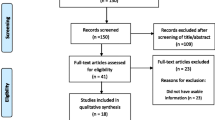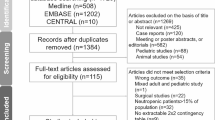Abstract
Only a few studies have investigated the use of PCT in the diagnosis of bone and joint infection, and these studies have had relatively small sample sizes. We performed a systematic review and meta-analysis of the diagnostic performance of serum procalcitonin (PCT) in the identification of osteomyelitis and septic arthritis in patients who present with fever and orthopedic symptoms. EMBASE, MEDLINE, and Cochrane databases and the reference lists of relevant articles were searched, with no language restrictions, through February 2012. All original studies that reported the use of serum PCT alone or in comparison with other biomarkers for diagnosis of osteomyelitis and septic arthritis were included. Seven studies qualified for inclusion. These studies enrolled a total of 583 patients with suspected bone or joint infection, 131 of whom had confirmed osteomyelitis or septic arthritis. Analysis of the PCT data indicated a bivariate pooled sensitivity of 0.67 (95 % CI: 0.37–0.88), specificity of 0.90 (95 % CI: 0.78–0.96), a positive likelihood ratio (LR+) of 6.48 (95 % CI: 2.28–14.6), and a negative likelihood ratio (LR−) of 0.37 (95 % CI: 0.16–0.84). Use of a lower PCT cut-off value (0.2–0.3 ng/mL) improved the LR + to 6.66 and the LR− to 0.15. Analysis of the three studies that also measured serum C-reactive protein (CRP) indicated that CRP had an LR + of 1.39 (95 % CI: 1.17–1.65) and an LR− of 0.40 (95 % CI: 0.12–1.36). Our results indicate that PCT may be more suitable as an aid for rule-in diagnosis rather than for exclusion of septic arthritis or osteomyelitis and that use of a lower cut-off value for serum PCT may improve its diagnostic performance.




Similar content being viewed by others
References
Margaretten ME, Kohlwes J, Moore D, Bent S (2007) Does this adult patient have septic arthritis? JAMA 297:1478–1488
Sawyer JR, Kapoor M (2009) The limping child: a systematic approach to diagnosis. Am Fam Physician 79:215–224
Carpenter CR, Schuur JD, Everett WW, Pines JM (2011) Evidence-based diagnostics: adult septic arthritis. Acad Emerg Med 18:781–796
Assicot M, Gendrel D, Carsin H, Raymond J, Guilbaud J, Bohuon C (1993) High serum procalcitonin concentrations in patients with sepsis and infection. Lancet 341:515–518
Brunkhorst FM, Heinz U, Forycki ZF (1998) Kinetics of procalcitonin in iatrogenic sepsis. Intensive Care Med 24:888–889
Maier M, Wutzler S, Lehnert M et al (2009) Serum procalcitonin levels in patients with multiple injuries including visceral trauma. J Trauma 66:243–249
Okada Y, Minakami H, Tomomasa T et al (2004) Serum procalcitonin concentration in patients with Kawasaki disease. J Infect 48:199–205
Chen DY, Chen YM, Ho WL, Chen HH, Shen GH, Lan JL (2009) Diagnostic value of procalcitonin for differentiation between bacterial infection and non-infectious inflammation in febrile patients with active adult-onset Still’s disease. Ann Rheum Dis 68:1074–1075
Butbul-Aviel Y, Koren A, Halevy R, Sakran W (2005) Procalcitonin as a diagnostic aid in osteomyelitis and septic arthritis. Pediatr Emerg Care 21:828–832
Faesch S, Cojocaru B, Hennequin C et al (2009) Can procalcitonin measurement help the diagnosis of osteomyelitis and septic arthritis? A prospective trial. Ital J Pediatr 35:33
Fottner A, Birkenmaier C, von Schulze Pellengahr C, Wegener B, Jansson V (2008) Can serum procalcitonin help to differentiate between septic and nonseptic arthritis? Arthroscopy 24:229–233
Hugle T, Schuetz P, Mueller B et al (2008) Serum procalcitonin for discrimination between septic and non-septic arthritis. Clin Exp Rheumatol 26:453–456
Martinot M, Sordet C, Soubrier M et al (2005) Diagnostic value of serum and synovial procalcitonin in acute arthritis: a prospective study of 42 patients. Clin Exp Rheumatol 23:303–310
Soderquist B, Jones I, Fredlund H, Vikerfors T (1998) Bacterial or crystal-associated arthritis? Discriminating ability of serum inflammatory markers. Scand J Infect Dis 30:591–596
Talebi-Taher M, Shirani F, Nikanjam N, Shekarabi M (2012) Septic versus inflammatory arthritis: discriminating the ability of serum inflammatory markers. Rheumatol Int 25:25
Whiting P, Rutjes AW, Reitsma JB, Bossuyt PM, Kleijnen J (2003) The development of QUADAS: a tool for the quality assessment of studies of diagnostic accuracy included in systematic reviews. BMC Med Res Methodol 3:25
Akobeng AK (2007) Understanding diagnostic tests 2: likelihood ratios, pre- and post-test probabilities and their use in clinical practice. Acta Paediatr 96:487–491
Halkin A, Reichman J, Schwaber M, Paltiel O, Brezis M (1998) Likelihood ratios: getting diagnostic testing into perspective. QJM 91:247–258
Simon L, Gauvin F, Amre DK, Saint-Louis P, Lacroix J (2004) Serum procalcitonin and C-reactive protein levels as markers of bacterial infection: a systematic review and meta-analysis. Clin Infect Dis 39:206–217
Nikfar R, Khotaee G, Ataee N, Shams S (2010) Usefulness of procalcitonin rapid test for the diagnosis of acute pyelonephritis in children in the emergency department. Pediatr Int 52:196–198
Berg P, Lindhardt BO (2012) The role of procalcitonin in adult patients with community-acquired pneumonia—a systematic review. Dan Med J 59:A4357
Mofidi R, Suttie SA, Patil PV, Ogston S, Parks RW (2009) The value of procalcitonin at predicting the severity of acute pancreatitis and development of infected pancreatic necrosis: systematic review. Surgery 146:72–81
Streit G, Alber D, Toubin MM, Toussirot E, Wendling D (2008) Procalcitonin, C-reactive protein, and complement-3a assays in synovial fluid for diagnosing septic arthritis: preliminary results. Joint Bone Spine 75:238–239
Spahr L, Morard I, Hadengue A, Vadas L, Pugin J (2001) Procalcitonin is not an accurate marker of spontaneous bacterial peritonitis in patients with cirrhosis. Hepatogastroenterology 48:502–505
Viallon A, Desseigne N, Marjollet O et al (2011) Meningitis in adult patients with a negative direct cerebrospinal fluid examination: value of cytochemical markers for differential diagnosis. Crit Care 15:R136
Volante E, Moretti S, Pisani F, Bevilacqua G (2004) Early diagnosis of bacterial infection in the neonate. J Maternal-fetal Neonatal Med: Off J Eur Assoc Perinatal Med, Fed Asia Ocean Perinatal Soc, the Int Soc Perinatal Obstet 16 [Suppl 2]:13–16
Steinbach G, Rau B, Debard AL et al (2004) Multicenter evaluation of a new immunoassay for procalcitonin measurement on the Kryptor System. Clin Chem Lab Med 42:440–449
Acknowledgements
We thank Medical Wisdom Incorporation for help with the statistical analysis.
Funding
None declared.
Conflict of interest
None declared.
Author information
Authors and Affiliations
Corresponding authors
Rights and permissions
About this article
Cite this article
Shen, CJ., Wu, MS., Lin, KH. et al. The use of procalcitonin in the diagnosis of bone and joint infection: a systemic review and meta-analysis. Eur J Clin Microbiol Infect Dis 32, 807–814 (2013). https://doi.org/10.1007/s10096-012-1812-6
Received:
Accepted:
Published:
Issue Date:
DOI: https://doi.org/10.1007/s10096-012-1812-6




